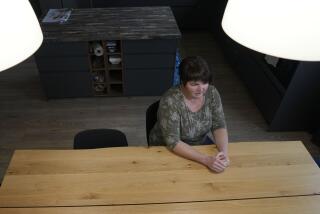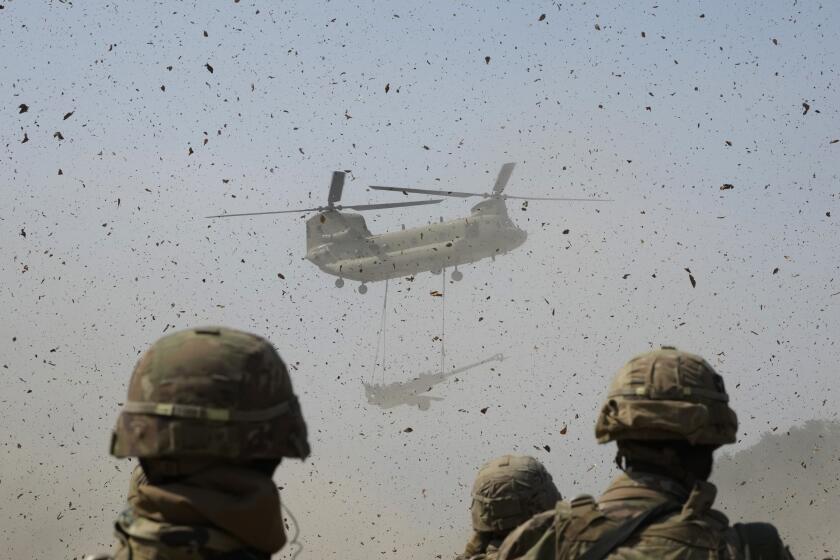Srebrenica Serbs Scoff at Reports of Mass Killings
- Share via
SREBRENICA, Bosnia-Herzegovina — A kind of normalcy is returning to life here. Children with backpacks walk home from school. Women pick flowers. And thousands of Bosnian Serb refugees have moved into the homes left behind by Muslims who fled last July’s Serbian takeover of Srebrenica, which triggered the alleged massacre of thousands of unarmed men.
For most of the West, Srebrenica has come to symbolize the atrocities of the Bosnian war. But for many Serbs now making their homes among the ruins, the truth is something else. They are convinced that nothing untoward happened here, certainly nothing any worse than crimes committed against Serbs.
“It bothers me that every day we hear on the news, ‘Srebrenica this, Srebrenica that,’ ” said Mika Cosic, 44, an engineer who took refuge in the city last August. “They constantly speak of Srebrenica. But we also suffered, and no one mentions that. I think what people say about Srebrenica is much more than actually happened.”
Cosic, who escaped her hometown of Glamoc when it fell to Muslim-Croat forces, was seated in the well-appointed living room of a salmon-colored house on the outskirts of town. The real owner, an elderly Muslim man, is among the estimated 8,000 people missing since the takeover of Srebrenica.
“We whitewashed the place and have been cleaning every day since August,” she said, describing the mess the house was in when she arrived. “We are still cleaning.”
Srebrenica was a U.N.-designated “safe area” when Bosnian Serb forces overran the town and drove more than 30,000 people into flight. Men were separated from women, and many were reportedly executed, killed in ambushes--or they vanished. Women told of rapes by Serbian soldiers.
International war crimes investigators this month began surveying sites in the Serb-held hills and valleys around Srebrenica where many of the missing may have been buried in mass graves. They collected samples of skeletons, clothing and human remains.
On the edge of one of the suspected mass graves, about 20 miles from Srebrenica, sits a two-story, red brick house where Bozica Vujadinovic, her husband, daughter, son-in-law and three granddaughters are making their new home.
“We didn’t know! We didn’t know!” Vujadinovic, 62, said over and over when asked how it feels to live next to a possible mass burial site.
She and her family moved in in January after fleeing Iljas, a Sarajevo suburb that reverted to Muslim-Croat government control under terms of the peace accord brokered last fall in Dayton, Ohio. They figured out something was amiss when they noticed surveillance aircraft from the North Atlantic Treaty Organization making regular passes above and American soldiers and hordes of journalists traipsing through their backyard.
“But what can I do and where can I go?” Vujadinovic moaned, leaning against a rusty rake. “I cannot simply crawl into the ground. You just spend each night and stay silent.”
The Vujadinovic clan chose this particular real estate because the house was a little less damaged than most and they had heard that the owner was a Muslim, so they figured the place was available. Fortunately, they brought a roof with them from Iljas, since the house didn’t have one.
Now they wonder if they can plant crops in the surrounding fields to keep from starving.
Less than a mile away at the St. Sava elementary school, children attend class and play soccer in the gymnasium even though the international war crimes tribunal at The Hague is investigating reports that hundreds of men from Srebrenica were held inside the building before being hauled off and executed.
At a suspected mass grave near Glogova the other day, the war crimes team stumbled upon a naked couple locked in amorous embrace in the back of a car.
And at Kravice, another alleged execution site, two dozen sheep were penned up and grazing inside a warehouse where, a few days earlier, war crimes investigators had pored over walls covered with bullet holes and, apparently, blood. It is suspected that hundreds of Muslims were executed there.
A farmer with a pitchfork strode in casually, lifted a stack of hay and fed the bleating sheep. He seemed oblivious to the walls, where investigators’ evidence markers were still posted, numbering each bullet hole and sign of death.
Elsewhere in Kravice, villagers weren’t talking about what might have happened to the Muslims of Srebrenica. Instead, they recalled the 1993 Christmas Day attack led by Muslim commander Naser Oric. The town fell, temporarily, into Muslim hands, and scores of Serbs were killed. It was the brutality of Oric’s attack, and the guerrilla raids he continued to launch from Srebrenica, that some Bosnian Serbs say justified the actions taken against the city’s Muslims.
“We cannot forget the Muslims destroyed our houses. We cannot forget our children who were killed,” said Mira Stjepanovic, 41, whose brother was killed in an ambush. “This world should not blame only the Serbs. We have our graves. We have our dead bodies in the forest.”
She was busying herself in the small creek-side home that she owned before the war and that she has now recovered, along with her old friend and neighbor, Milan Zivanovic.
Zivanovic, 35, is hoping he will again be able to work at the sprawling bauxite mines near Srebrenica now that Serbs control the territory. As for the Muslim men from Srebrenica, both Zivanovic and Stjepanovic say they can’t imagine what happened to them.
“They just probably wandered off somewhere after Srebrenica was liberated,” Zivanovic said. “The Muslims have strong propaganda. That’s why Serbs are always blamed.”
Up on a hill above Kravice, the bones and civilian clothing of about 20 or 30 men, believed to be Muslims from Srebrenica, lie scattered among new wildflowers. Serbian farmers from the area are going about their spring routine of burning off the brush to prepare the hillside for planting, incinerating some of the clothing at the same time.
And in the heart of Srebrenica, residents offer a collective shrug at the stigma seen from the West. Most of the region has been flooded with Bosnian Serb refugees, effectively diluting any pool of eyewitnesses and giving everyone a comfortable margin of denial.
Cosic, the Serb now living in a missing Muslim’s house, said she is curious about the people who were there before. She found a large number of books, some by Yugoslavian Nobel laureate Ivo Andric, and a photo album inscribed with the dedication “To Cica for 18th birthday, from Djoka.” There were old pictures of weddings, children, trips to the beach.
“I was really interested, but people around here know very little,” she said. “Everyone is a refugee. We asked, but no one knows.”
Told that the original occupants were said to be affluent, Cosic was skeptical. Other homes, she said, were much nicer than the one she received as a grant from Bosnian Serb authorities.
“Other houses had fireplaces, central heating,” she said. “This place only had one bathroom, and such an old bathtub I had to throw it out. And there was no washing machine. I wouldn’t call them rich.”
Srebrenica was a mass of trash and flies when the refugees began arriving, and there still is no water or electricity and little humanitarian aid. It is these primitive conditions that make Cosic long to leave, to find a better place to live.
As for the Muslims, she said she believes they got much better treatment than Bosnian Serb refugees. She saw television footage of buses provided for the Muslims of Srebrenica; the Serbs from her hometown and other Serbian areas, meanwhile, had to leave in their own cars and with little help.
“Of course they had it better,” she said. “The whole world knows that.”
When Srebrenica fell, many of the Muslims were filmed boarding buses marshaled by Bosnian Serb army commander Gen. Ratko Mladic. Later, many were removed from the buses and never seen again. The episode has been characterized by international human rights organizations as the worst atrocity in Europe since World War II.
“It’s all blown out of proportion [by the Muslims] to get as many points as possible and to blame the Serbs for everything,” Cosic said.
More to Read
Sign up for Essential California
The most important California stories and recommendations in your inbox every morning.
You may occasionally receive promotional content from the Los Angeles Times.














